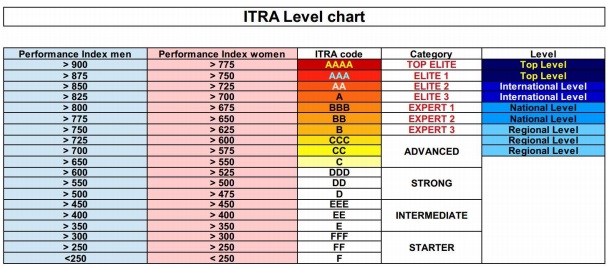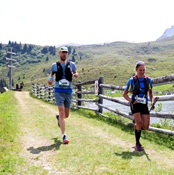
THE MESSAGE FROM DIDIER CURDY, THE ORIGINATOR OF THE ITRA PERFORMANCE INDEX, EXPLAINS:
 “Following numerous discussions among the ITRA community, and with runners, organizers and journalists, the ITRA ranking committee has undertaken to improve the way in which the Performance Index is calculated, in order to better reflect runners’ performances by slowly decreasing the value of any given result. At the same time, the ranking table – which dates back to the creation of ITRA – has been adjusted to take into account the improvement in the overall level of all trail runners. We are delighted to be able to present these latest major developments”.
“Following numerous discussions among the ITRA community, and with runners, organizers and journalists, the ITRA ranking committee has undertaken to improve the way in which the Performance Index is calculated, in order to better reflect runners’ performances by slowly decreasing the value of any given result. At the same time, the ranking table – which dates back to the creation of ITRA – has been adjusted to take into account the improvement in the overall level of all trail runners. We are delighted to be able to present these latest major developments”.
EVOLUTION OF THE INDEX OF PERFORMANCE
To remind readers, the performance index expresses your potential speed in trail races. It is calculated by taking a weighted average of your 5 best performances over the last 36 months.
The overall index of performance takes into account the top 5 results from all the races together, while there is also an index of performance for each category of trail. For a deep dive into the details, please visit the following page: FAQ Index of performance
WHY CHANGE THE PERFORMANCE INDEX?
In response to the wishes of the ITRA community and with a view to continuing to improve the tools provided, ITRA sought to update the calculation of the performance index such that a greater weighting is given to more recent races, thus providing a more accurate reflection of
reality – i.e. generally speaking, the more recent a result, the greater its weighting in calculating the index of performance.
WHAT ARE THE CHANGES?
Each result taken into account in calculating the index of performance (general or by category) is now assigned a coefficient in accordance with the date of the race. For the first 12 months after a race, a result is given its full weighting in the calculation. After the first 12 months, the
weighting of the result is progressively reduced. Using a negative coefficient that decreases every six months, the result still counts but its weighting in the calculation is reduced. Thus, the index of performance will decrease if the runner runs no further races. On the other hand,
the index of performance will continue to improve if the runner achieves better results – as was already the case.
For the general performance index, the rate of decrease for the period will remain the same whatever the length of the races.
For the performance index by category, however, the rate of decrease goes up according to the category of trail; the lower the category in terms of effort/km, the faster the decrease in the weighting of a result. Why this additional factor? Simply because for any given period, an ultra-runner will run far fewer races than a short-distance runner, who will consequently have more results.
Finally, it is important to note that a result score in the runner’s file will always remain the same (910 will always appear as 910). The coefficient that reduces the weighting of a result only applies to the calculation of the index of performance and not to the score for the race.
WHAT WILL THIS MEAN?
▪ The immediate effect is that the index of performance (general and by category) for each trail runner will change significantly with this new method of calculation. Thus, runners will see their index of performance increase or decrease according to whether
their best results were achieved recently or longer ago.
▪ As a result, the classification into the different indices of performance (general and by category) has been completely reordered.
Below the top 6 men with the previous performance index calculation:

Below the top 6 men with the new performance index calculation:

Below the top 6 women with the previous performance index calculation:

Below the top 6 women with the new performance index calculation:

▪ The indices of performance will be less rigid and more dynamic. Rankings are constantly changing.
▪ Individual performance indices and rankings will be more consistent with current reality.
WHERE TO FIND THE NEW INDEX OF PERFORMANCE?
Find your index of performance on your profile. For a few months, you will be able to compare the old and the new index. ITRA members with paid subscriptions can find a complete list of the new performance index rankings for all runners by clicking on “My account”, then on “Index
of performance” where, for the next few months, you will be able to compare the old and new index of performance for every runner.
CHANGES IN THE TABLE OF RANKINGS.
WHAT IS THE PURPOSE OF THE TABLE OF RANKINGS?
This table groups the indices of performance by ranking and gender in such a way that it is possible to define different categories of trail runners ranging from the beginner, or local level, to the top elite, or international level.
A runner will be able to gauge the level at which he is performing: “Can I consider myself a beginner, an advanced, or an elite runner? Do I compete at a local level or can I claim to be winning national races?” Organizer can use this table to estimate the level of their race or to determine their policy with regard to elite registration for example.
WHAT IS THE REASON FOR THE CHANGES?
The table was created when ITRA was first set up. Since the general level of runners has risen, it has become necessary to refine this table and to redefine the ratings in order to clarify the concept of elite runners and the classification of all runners.
WHAT ARE THE CHANGES?
The categories have been refined. A new category, top elite, has been created. This category – for men with a score of 900 and above and women with a score of 775 and above – comprises a very small number of runners, namely the very best in the world.
The levels for men and women have been redefined to fine-tune the classification of trail runners.
WHAT WILL THIS MEAN?
The elite level has been redefined by raising the entry level to above 825 for men whereas previously it was above 800. In women it is considered to be above 700. Within each level, progression is more linear – in particular with the introduction of a new category, “strong”.

INFO: ITRA












































